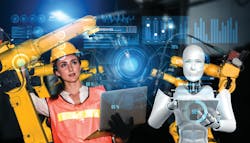Imagine having a resource powered by artificial intelligence (AI) that works 24/7 and answers your safety-related questions anytime you ask. It gets so good that it starts predicting your requests and automatically sends responses. Eventually, you have every piece of information you want in your hands before you even ask, providing you with a superpower with respect to safety.
That vision is closer to reality than we may think. AI-powered personal assistants already surround us, from Alexa home devices to Siri on iPhones and Apple watches to the online shopping applications that make suggestions based on our location and purchase history. AI assistants for company safety work in similar ways. The power—and also the challenge—of applying artificial intelligence to safety is that the system is tracking millions of data points to analyze, report and make recommendations on safety for tens to thousands of employees.
Let’s look at how artificial intelligence can be applied to a company’s safety initiatives, how to provide the data necessary for delivering meaningful results with an AI assistant and how to get the answers you need from an AI assistant.
Applying AI Assistants to Safety
When we think of AI as applied to digital assistants, a more suitable description is cognitive computing. This means training computers how to learn, reason, communicate and make decisions all on their own. Cognitive engines are trained rather than programmed, allowing them to learn how to complete tasks traditionally performed by people. This is important because it means that safety managers do not need to be data scientists to obtain meaningful insights; the AI assistants will learn from managers and improve their responses over time.
When applying AI to managing safety, there are three general components:
- A natural language processing (NLP) / understanding algorithm, which lets safety managers make requests that the AI assistant responds to.
- Machine learning (ML), which is the neural network that scans data to locate patterns. Increasingly, these technologies are being built into business applications to extend their functionality.
- A visual component such as a closed-circuit TV (CCTV) to observe workers at a jobsite or on the shop floor or an optical character reader (OCR) to convert paper records into digital data that can be analyzed.
AI assistants in safety may track data from CCTVs capturing images of workers using a machine in a way that is ergonomically incorrect, allowing safety managers to proactively intervene before the company starts seeing repetitive use injuries among employees.
Alternatively, AI assistants can scan 1,000 hazard assessments in your database to identify the 10 that answered “no,” so you can focus on this small group of anomalies and apply a remedy.
Consider also walking on the shop floor and seeing a worker on a Genie lift. You could text the AI assistant to see if that person has been trained to use the Genie. Maybe the response is that the employee has been trained, but their certification has expired, so a safety bot has scheduled training for the worker.
These are just a few examples of how AI assistants can play a powerful role in mitigating risk. However, before safety managers can reap the benefits of artificial intelligence, they must first collect the data to be analyzed.
Collecting Usable Data
The first step to any analytics project is to clean and normalize the data, structuring it in such a way that it is repeatable across all existing records. Whether data is currently stored in a file cabinet, spreadsheets, PDFs or Google Docs, it is not likely to be indexed and the same for every record. This information needs to be entered into a database that structures the data for consistency. However, the process can cost tens or hundreds of thousands of dollars and take months or years to complete, causing many projects to stall before they ever get started.
For this reason, it is more effective to start by digitally collecting new data using applications, such as those for environmental, health and safety (EHS); human resources (HR); and enterprise resource planning (ERP). Such applications automatically normalize the data and store it in some form of database, starting you on the path of generating insights without the capital investment required to transcribe or alter historical records.
We’ve found that in as little as four weeks, safety managers and directors who start collecting data digitally are able to gain important insights from their safety programs.
Ideally, all employees are contributing data. Mobile applications and web apps that can be accessed via mobile phones provide an easy way for workers to input data that is automatically normalized and ready for analysis. Additionally, technologies, such as Quick Response (QR) codes, provide a way to identify individual employees via their mobile phones and effectively act as digital signatures that can be stored and tracked with other information.
We’ve found that in as little as four weeks, safety managers and directors who start collecting data digitally are able to gain important insights from their safety programs. It is then possible to go back and normalize those historical records most likely to enrich AI-driven analysis.
Once data has been normalized or cleaned, it can be used in a meaningful way. We can even use human intelligence to gain insights into safety. These insights, in turn, can be employed to create a business case to the company’s financial executives for investing in AI.
At the same time, simply having normalized data in place is not enough to use artificial intelligence effectively. What data you collect will affect how meaningful the AI-driven results are.
I spoke with someone from an association that had collected data for four years, but none of it revealed any new insights. That’s because the organization made two common mistakes. First, it captured age groups rather than individual ages. Second, it did not normalize the data around active workers. So, for example, it showed there were more injuries in June, but it didn’t account for the fact that there were also more workers onsite that month.
In general, it is better to collect more data because the machine learning component of the AI assistant can scan the data to find connections that humans might miss. Many times, we don’t know what we don’t know, and it takes an AI assistant to shine a light on those new correlations and trends.
Training an AI Assistant
AI assistants are cognitive engines that train themselves over time. However, once the AI functionality is in place, safety managers will still have to assist with that training. It’s similar to training a new human assistant; the only difference is that you may need to communicate using a specific set of interactions that it can recognize.
The first step is to ensure that when you make a request, such as how many near-miss reports were generated last month, the AI assistant can access the data needed to send an answer. It will look through the data and send a response that may read “There were 54 near-miss reports submitted in the last month.” Or, it might need clarification of the requested time frame, such as “for the past 30 days” or “for the last calendar month.”
Once you have the answer, you could request a summary e-mail. At that point, you’ve just used the AI assistant to build a report on near-miss reporting in a few minutes with three lines of communication:
- How many near-miss reports were submitted last month?
- Look at the last 30 days.
- E-mail me the summary.
By comparison, some safety managers can take anywhere from hours to even weeks or months to gather all the information for the status of near-miss reports.
For now, AI assistants are slightly limited in what they have been trained to recognize, but eventually they will get to a point of language understanding where we won’t have to word things in a specific way. Using familiar apps such as text messaging and e-mail systems to gain insights grounded in common sense and in real-time will reduce the time it takes AI assistants to learn and add value. Sometime, in the not too distant future, you will be able to call AI assistants and make complex requests that they will be able to fulfill, further facilitating your decision-making and improving productivity.
The potential AI assistants have to reshape how we maximize safety in the workforce is tremendous. The first step is collecting data around safety performance in a digital, normalized structure. Even if you are not yet ready to jump on the AI bandwagon, putting the proper digital data collection in place today will have you well-positioned to harness the power of AI assistants tomorrow.
Ryan Quiring is co-founder and CEO of SafetyTek, a provider of digital workplace safety management software.
Related articles on AI and data analytics:
AI, Humans and Collaboration in the Workplace

